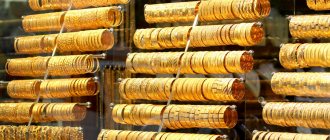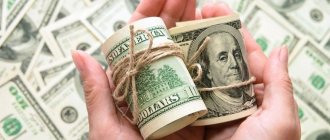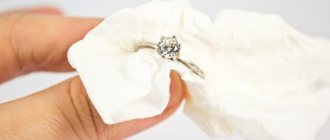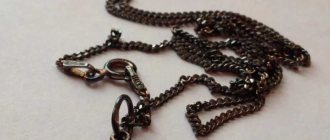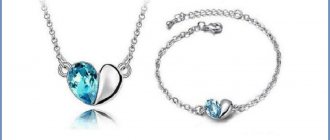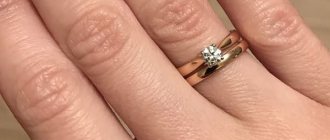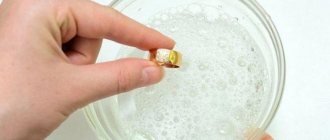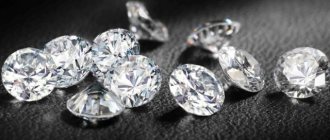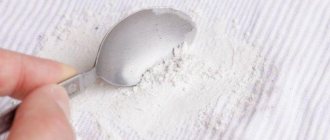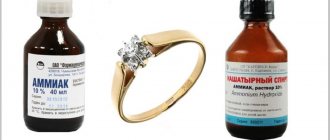Distinguishing gold from fake gold at home is not as difficult as it might seem at first. Everyone knows the “tooth test” method, but in reality it is of little use - after all, only pure gold is soft. And jewelry or products made of pure metal are almost impossible to find. Whether to check gold or not is a personal matter for everyone, but we still advise you to take a closer look at the jewelry to avoid unpleasant moments. A few simple methods that we will talk about today are worth adopting - because you never know where new knowledge will come in handy.
Look at the sample
Factory products always have a standard stamp with a hallmark. Fineness is the number of grams of pure metal in the alloy; the lower it is, the worse the quality.
According to Decree of the Government of the Russian Federation dated May 6, 2016 No. 394, all alloys in which more than 30% of the weight is precious metal must be stamped with hallmark. Standard samples for gold are 375 (lowest), 500, 583, 585, 750, 916, 958, 999 (highest - only 1 g of impurities per 1 kg of metal).
In the USA and Canada, carat hallmarks are used (9 carats correspond to the 375th hallmark, 24 carats correspond to the 999th). Moreover, the letter K next to the numbers means that the product itself is gold, and KGP means that it is plated with gold (karat gold plated).
In Belgium, gold samples are designated by numbers: 1 – 833, 2 – 750, 3 – 585. A similar system works in the Czech Republic and Slovakia: 0 – 999, 1 – 986, 2 – 900, 3 – 750, 4 – 585.
Examining a sample is often difficult. Use your smartphone in macro mode, then enlarge the photo and look at the sample in detail. The mark should not be crooked or blurry. This is, if you like, a passport of the product, so they are very careful when applying it.
Characteristics of precious metal
Gold is a metal that is resistant to external factors, durable and beautiful, but at the same time very soft. That is why there is no jewelry made from pure precious metal; other chemical elements are necessarily added to the alloy:
- yellow gold - a combination of equal parts of silver, copper and gold itself;
- red gold - 25% copper;
- white gold - contains 32% gold, the rest is an alloy of platinum and nickel.
Pure gold is marked with a purity of 999. The 958 purity contains 96.3% pure gold. Such materials are rarely used for making jewelry - they are very soft.
Attach a magnet
Plating steel or other alloys with a high iron content with gold or its imitation is a common practice. Only ferromagnets are strongly magnetic - iron, cobalt, nickel, gadolinium, terbium, dysprosium, holmium, erbium, thulium.
Dimagnets (for example, water or table salt) and paramagnets (aluminum, etc.) are weakly magnetic. All non-ferrous metal is not magnetic.
If it happens on the beach or in places where tourists gather, buy the cheapest magnet in a souvenir shop and attach it to the product. If it sticks, it’s definitely a fake or the metal is of too low standard (too many iron impurities). If not, perform other checks.
Is gold magnetic?
For many decades, the famous “grandmother’s” method of testing gold was considered one of the most reliable and safe, because products made of precious metal are not magnetic at all. However, this technology is becoming less in demand every year, and here’s why:
- Most counterfeits on the market began to be made from a special copper-lead alloy, which in its structure is similar to a diamagnetic material.
- For the most accurate verification, an expensive neodymium magnet is required - miniature decorative jewelry “from the refrigerator” is absolutely unreliable.
The best modern tester is the once popular toy Neocub. The composition of its balls is the same neodymium alloy, which has the required attractive power.
Test with vinegar
Tell the seller that you will test the gold with vinegar. Are you nervous? There’s no need to run to the grocery store anymore. But a professional who is confident in his product will not sweat it.
Fake gold quickly darkens in vinegar - just pour a little into a glass and hold the metal in it for about five minutes. But real high-grade metal doesn’t care about anything.
Checking using available tools
If you have any doubts about the authenticity of gold jewelry, it is recommended to check it using available means. Typically, vinegar, iodine or black bread are used for such purposes. In addition, there are a number of options that will help you distinguish gold from other metals yourself. This check can be done as follows:
- Vinegar. Pour a little vinegar into a ceramic or plastic dish and place the jewelry in there for a few minutes. If the metal is real, it will not change color or become stained. The fake will definitely darken.
- Iodine. You need to drop it on the jewelry and wait 5 minutes, then wipe the product with a napkin. One drop is enough to distinguish real gold from fake gold at home. A ring that has darkened or turned greenish will confirm that it is fake.
- Black bread. You will need a crumb in which to place the product. You need to roll the ball so that the decoration is in the middle of it, and leave it for a couple of days until it becomes stale. This jewelry will not change color and will shine as usual. If it turns out to be an alloy, it will become dark as it undergoes oxidation.
- Lapis pencil. This drug can be bought at a pharmacy. It is used to treat wounds and stop bleeding. To determine whether it is gold or costume jewelry, you need to wet the item and draw a line along it with a lapis pencil, then wipe it with a dry towel. On real gold there will be no trace of the drawn line. If the stripe remains after wiping the product, then it is definitely a fake.
- Magnet. To distinguish gold from copper or other alloys, it can be tested using a magnet. The decoration should be applied to it and see if it is attracted. Pure gold does not react to a magnet in any way. A slight pull will indicate that the product contains copper. Aluminum and tin can also be in an alloy; they do not react to a magnet. And such jewelry will weigh less than real gold rings or earrings.
- Nitric acid. An authenticity test using this chemical compound will accurately indicate whether an item is genuine. For the experiment you will need a deep metal bowl. Place the decoration in it and add just one drop of acid. A change in color to milky or green will be a bad sign, indicating that a fake ring or bracelet was purchased.
- Needle test. This method is suitable to eliminate gilding. If you scratch with a needle, there will be no marks left on the gold ring. As for the gilding, it will peel off.
- Ceramic tile. Other metals or alloys leave a dark or grayish mark on the surface when rubbed across the tile. A gold ring will leave a golden mark.
- Sun test. This check can be carried out on a bright sunny day. First you need to carefully examine the decoration in the shade. Then do the same in sunlight. Real gold does not change its shine and appearance in any light and in any weather conditions.
- Archimedes' method. This method will require certain knowledge and effort. A deep bowl must be filled with water, having first measured its volume. Carefully place all decorations into the container until the liquid pours out. According to Archimedes' law, an object immersed in water is subject to a buoyancy force that is equal to the weight of the liquid itself in the volume of the immersed object. Knowing that the density of water is 900 kilograms per 1 cubic meter, we can use the formula to calculate the mass of a gold product. The gold should sink because its weight will be greater than the volume of liquid poured out.
Using a couple of these methods, you can make sure whether the jewelry is gold, copper or made of bronze.
Drop some iodine
Rub the product on jeans or other thick fabric, then drop iodine on this place on the metal. High standard gold does not darken. If the metal has darkened (this may appear within a minute), the product is not genuine or the standard is not too high.
But brass and copper do not change color from iodine either. So this testing method is good for high-grade gold, but it is not enough on its own.
We do not recommend testing products with iodine levels of 585 or lower. After iodine, you will definitely have to polish them or remove stains with ammonia; traces may remain.
How to determine gold purity
It is convenient to use an electronic detector at home. You can purchase it at a jewelry store at a low price. Used to accurately determine samples from 333 to 750. Values are shown in carats (from 6 to 18).
The chemical method is carried out using reagents.
For samples of 600 and less, gold chloride is used. For higher levels - acid.
The sample is determined by the color of the resulting spot. The brighter it is, the lower the sample. For example, light brown color characterizes sample 585, green - 375. This method is more often used by specialists.
Draw with lapis pencil
A lapis pencil is needed to stop the bleeding. This is an antiseptic based on silver nitrate, it can be bought at a pharmacy, it costs about 100-150 rubles.
To check the authenticity of gold, soak the item in water. Then, using a lapis pencil, draw a small line over the wet one and wipe it off.
Lapis does not react with gold, but does react with other metals. If a trace remains, then the gold is fake or of very low standard. Nothing will happen to genuine metal.
How to visually distinguish gold when purchasing in a store?
Before removing your bank card from your wallet, please note the following:
- Each product made in Russia must be marked with a hallmark of 375 or 585 together with the logo of the Federal Assay Office - a woman’s profile in a kokoshnik. The print should be clear, without blurred edges. To view, use a magnifying glass - there is nothing “criminal” about consumer meticulousness.
- If the decoration is composite with a complex openwork shape, then you will see solder at the joints of the elements. Upon closer inspection, there is a slight difference in shades - this is due to the use of a purer composition, this is a good sign.
- Hold the product in your hands for a few minutes to warm it up, and then smell it. Real gold does not emit any odors, unlike copper alloy jewelry.
After examining the item itself, we proceed to inspect the accompanying documents - tags and catalog cards, where key information about the product is always indicated:
- Article, full trade name, type: T108023275 Earrings with pearls;
- Legal name of the manufacturer, head address, city of Yaroslavl, Sobinova street, building 47a
; - Mark of the technical control department: quality control department stamp and examination number;
- Technical information about the product - sample, weight, type of insert;
- Date of manufacture;
- Barcode;
- QR code with an encrypted link to the product position in the electronic catalog.
Only after making sure that all formal requirements are met should you make a purchase in a retail store and then begin a home inspection.
Test with black bread
The method is safe (for real gold!), but slow. Take the crumb of black bread, remember, mix with water and stick the mixture onto the product. Leave it until the bread crumb turns into a dry crust, then break it apart.
If there are dark traces inside the crumb, it means the fake has oxidized. If not, then it is either gold or good gilding.
Category: question-answer
I checked the ring to see if it was gold or not. How can I get rid of iodine stains now?
Expert opinion
Pribrezhny Gennady Valentinovich
Jeweler 6th category
Iodine blots can be easily cleaned with hydrogen peroxide and soap. Prepare a solution by mixing soap with peroxide and place the ring there for half an hour. After this, the ring will need to be rinsed with running water and wiped dry.
Will vinegar corrode gold when tested?
Expert opinion
Andrey Seleznev
Chemist-technologist, Volgograd
Solar metal is quite difficult to dissolve. This can only be done with the help of aggressive concentrated acids, nitric and hydrochloric, a mixture of which is also called aqua regia. Therefore, testing gold with vinegar will not give any reaction.
What does it mean if a gold ring is slightly attracted to a magnet?
Expert opinion
Grishanov Mikhail Petrovich
Jeweler, director of the Grishanov and Co. workshop
Most likely, the gold ring contains impurities, they can become magnetic. In such situations, it is worth assessing the force of gravity. If the ring is strongly magnetic, it makes sense to check it with a series of home tests.
High-quality gold transmits magnetic waves.
Gold ring on a magnet
Is it possible to test gold by tooth? How reliable is the method?
Expert opinion
Pribrezhny Gennady Valentinovich
Jeweler 6th category
The old verification method was relevant several centuries ago. The precious metal used for minting coins is very soft. Since the coins consisted mostly of it, people, fearing counterfeits, bit the money and examined the surface for signs of teeth.
Now it’s definitely not worth checking jewelry “by the tooth.” There are many other more reliable methods. In addition, it is very easy to make mistakes using only teeth.
Lead, for example, is even softer than the solar metal. If you bite it, marks will definitely remain.
I was given handmade gold earrings for my birthday, how can I check their authenticity and purity?
Expert opinion
Grishanov Mikhail Petrovich
Jeweler, director of the Grishanov and Co. workshop
It’s definitely worth turning to professionals in a jewelry workshop. Masters have all the necessary tools to obtain an accurate result. You can try to find out the sample yourself using a set of acids, but the resulting value will only be approximate. In addition, such a purchase is not practical for one-time use.
Don't try it on your teeth!
Gold is a soft metal, so if you squeeze it hard with your teeth, marks will appear. Agree, the seller will not like it and will force you to buy.
Athletes test their medals for the sake of photos. Moreover, gold medals are actually just gold plated.
By the way, fake aluminum behaves exactly the same way, so if the seller insists on a “teeth test”, don’t be fooled.
On the other hand, only a new product does not have even small scratches on the surface. If a person claims to be selling his used gold, but it appears to have only come from a factory, something is wrong here.
What is the difference between gold and gilding
Gilding - metal coated with a layer
gold. Different countries have certain requirements for the manufacture of gold-plated products.
On the market you can often find gold-plated jewelry, which is based on silver or an alloy of metals.
The concept of medical gold appeared thanks to marketing tricks. The alloy can be coated with a thin layer of gold, and sometimes can be made without it. The medical alloy is hypoallergenic and durable. Additional coating only decorates the product.
conclusions
If you buy gold secondhand or from an unverified store, use as many methods as possible to ensure the authenticity of the product. The main thing is not to try too hard, so as not to spoil the soft metal.
(
68 votes, overall rating: 4.40 out of 5)
